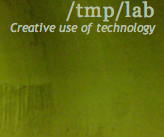PdTmpLab~3 - 27 octobre 2011
Les interfaces, le geste, tout particulièrement relatives aux membres supérieurs (mains, bras), relations homme/machine.
Discussion autour du travail de l'artiste, musicien, créateur etc. etc. Onyx Ashanti.
Personnellement, je ne suis pas fan de son travail, même si je le trouve intéressant... La critique que j'émettrai est que plastiquement, esthétiquement, au niveau de la gestuelle, blablabla, ça ne me parle pas... Pas suffisamment de sens, de relations entre ce que je vois et ce que j'entends... Je me pose toujours la question "est-ce que j'écoute quelque chose de plus ?" Et ma réponse est : "Et bien non ! Qu'est-ce que son interface apporte à sa musique ?" Mais c'est une opinion tout à fait personnelle... Ça n'engage que moi, cette opinion n'est pas représentative de celle de tous les participants de notre rencontre PdTmpLab.
Je préfère et de loin le travail de Michel Waisvisz :
Rien à voir avec Pd ! Certes, certes... Mais tout de même passionnant ! Et puis pas totalement hors des préoccupations des membres du Tmp/lab puisque :
"[...] Il militait pour que les artistes, afin d’éviter la « contamination » de leurs œuvres par le conformisme des outils de création standardisés, adaptent outils et instruments en les modifiant (cf. le concept de « Circuit Bending »), voire les construisent sur mesure. Dans les années ’70, en parlant des instruments électroniques, il lança le slogan : « Si tu ne l’ouvres pas, ce n’est pas à toi ! ». Cette maxime est devenue la profession de foi du STEIM : les créateurs de musique y sont en effet encouragés à jouer un rôle majeur dans la conception et la construction de leurs propres instruments destinés à la musique électronique en direct.[...]"
Ça, c'est dans l'esprit du Tmp/Lab où je quitte tout de suite !
Physical philosophy :
"He is the founder of Physical Philosophy. In Physical Philosophy, instead of using spoken or written language, the phenomenon of the physical act of manipulation of instrumental objects is considered the shortest and most precise expression of the axiom’s of philosophy. 'The act is it’s metaphor; the act overrules its description’. "
if our goal is musical expression we have to move beyond designing technical systems.
we have to move beyond symbolic interaction.
we have to transcend responsive logic;
engage with the system:
power it and touch it with our bodies,
with our brains.
invent it and discover it’s life;
embrace it as instrument.
an instrument that sounds between our minds.
we will have to operate beyond pushing buttons and activating sensors
beyond isolating gestures and mapping data and parameters
beyond calculating response
beyond assuming that the concept will create music
we should abolish the illusion of ‘control’
merge our intentions into those of the instrument and the audience
get inspired by change, miscalculation, invested instinct, insightful anticipation, surprise and failure
the sensors, the logic, the artistic debate, the technical debate, the circuits, the theories about perception,
the new war driven technologies, the ability or dis-ability to communicate, the conferences, the endless
experimentation with system tweaks, the touch and sound, the reoccurring state of disbelief, the craving for the stage, the difficult and great collaborations, composing the now, the survival of the electronic music scenes, the nime, the industry, the independents, the musical fun, the appreciation of difference,
the body as source of electrical and musical energy, the bonding of thinkers, the rapid improvisers,
... just to extrapolate some ingredients and vehicles of our quest.
it might work if we manage to express ourselves musically by moving beyond interaction,
beyond mere technical beliefs and disbelief.
by engaging, by trusting ourselves into the potential of our new instruments,
enchanting our sounds, our audience.
enchantment is not only a state of mind,'
it is a technology
designing for new musical expression is casting a spell on instrumental practice.
Michel Waisvisz, Limerlé May 2006

